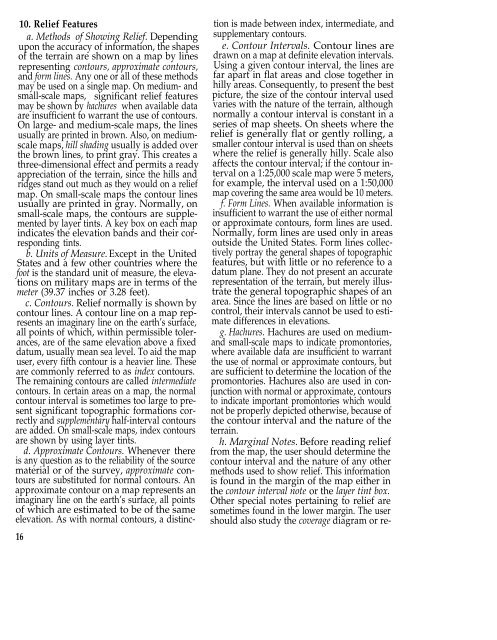US Army - FM 21-31 - Topographic Symbols.pdf
US Army - FM 21-31 - Topographic Symbols.pdf
US Army - FM 21-31 - Topographic Symbols.pdf
Create successful ePaper yourself
Turn your PDF publications into a flip-book with our unique Google optimized e-Paper software.
10. Relief Features<br />
a. Methods of Showing Relief. Depending<br />
upon the accuracy of information, the shapes<br />
of the terrain are shown on a map by lines<br />
representing contours, approximate contours,<br />
and form lines. Any one or all of these methods<br />
may be used on a single map. On medium- and<br />
small-scale maps, significant relief features<br />
may be shown by hachures when available data<br />
are insufficient to warrant the use of contours.<br />
On large- and medium-scale maps, the lines<br />
usually are printed in brown. Also, on mediumscale<br />
maps, hill shading usually is added over<br />
the brown lines, to print gray. This creates a<br />
three-dimensional effect and permits a ready<br />
appreciation of the terrain, since the hills and<br />
ridges stand out much as they would on a relief<br />
map. On small-scale maps the contour lines<br />
usually are printed in gray. Normally, on<br />
small-scale maps, the contours are supplemented<br />
by layer tints. A key box on each map<br />
indicates the elevation bands and their corresponding<br />
tints.<br />
b. Units of Measure. Except in the United<br />
States and a few other countries where the<br />
foot is the standard unit of measure, the elevations<br />
on military maps are in terms of the<br />
meter (39.37 inches or 3.28 feet).<br />
c. Contours. Relief normally is shown by<br />
contour lines. A contour line on a map represents<br />
an imaginary line on the earth’s surface,<br />
all points of which, within permissible tolerances,<br />
are of the same elevation above a fixed<br />
datum, usually mean sea level. To aid the map<br />
user, every fifth contour is a heavier line. These<br />
are commonly referred to as index contours.<br />
The remaining contours are called intermediate<br />
contours. In certain areas on a map, the normal<br />
contour interval is sometimes too large to present<br />
significant topographic formations correctly<br />
and supplementary half-interval contours<br />
are added. On small-scale maps, index contours<br />
are shown by using layer tints.<br />
d. Approximate Contours. Whenever there<br />
is any question as to the reliability of the source<br />
material or of the survey, approximate contours<br />
are substituted for normal contours. An<br />
approximate contour on a map represents an<br />
imaginary line on the earth’s surface, all points<br />
of which are estimated to be of the same<br />
elevation. As with normal contours, a distinc-<br />
16<br />
tion is made between index, intermediate, and<br />
supplementary contours.<br />
e. Contour Intervals. Contour lines are<br />
drawn on a map at definite elevation intervals.<br />
Using a given contour interval, the lines are<br />
far apart in flat areas and close together in<br />
hilly areas. Consequently, to present the best<br />
picture, the size of the contour interval used<br />
varies with the nature of the terrain, although<br />
normally a contour interval is constant in a<br />
series of map sheets. On sheets where the<br />
relief is generally flat or gently rolling, a<br />
smaller contour interval is used than on sheets<br />
where the relief is generally hilly. Scale also<br />
affects the contour interval; if the contour interval<br />
on a 1:25,000 scale map were 5 meters,<br />
for example, the interval used on a 1:50,000<br />
map covering the same area would be 10 meters.<br />
f. Form Lines. When available information is<br />
insufficient to warrant the use of either normal<br />
or approximate contours, form lines are used.<br />
Normally, form lines are used only in areas<br />
outside the United States. Form lines collectively<br />
portray the general shapes of topographic<br />
features, but with little or no reference to a<br />
datum plane. They do not present an accurate<br />
representation of the terrain, but merely illustrate<br />
the general topographic shapes of an<br />
area. Since the lines are based on little or no<br />
control, their intervals cannot be used to estimate<br />
differences in elevations.<br />
g. Hachures. Hachures are used on mediumand<br />
small-scale maps to indicate promontories,<br />
where available data are insufficient to warrant<br />
the use of normal or approximate contours, but<br />
are sufficient to determine the location of the<br />
promontories. Hachures also are used in conjunction<br />
with normal or approximate, contours<br />
to indicate important promontories which would<br />
not be properly depicted otherwise, because of<br />
the contour interval and the nature of the<br />
terrain.<br />
h. Marginal Notes. Before reading relief<br />
from the map, the user should determine the<br />
contour interval and the nature of any other<br />
methods used to show relief. This information<br />
is found in the margin of the map either in<br />
the contour interval note or the layer tint box.<br />
Other special notes pertaining to relief are<br />
sometimes found in the lower margin. The user<br />
should also study the coverage diagram or re-

















